WHAT'S NEW
ACROSS THE WORLD
Select date in side bar to go to a What's
New of previous issues
| What's New ©by
Laif DeMason
Unemployment in the United States
remains high. Typically during most recent recessions, stay at home
activities, such as tropical fish keeping, fare better than other
disposable income sectors. Currently, I cannot say this is true during
recent months. Some large tropical fish retailers on the East Coast
report that all sales are down. Other fish retailers on the West Coast
say common tropical fish are selling well, but cichlids are not. It is
unknown if any of these trends will last through this winter. Americans
seem to be pulling back on all types of purchases. Certainly many
retailers of all types of products have closed their doors for good. It
is more important than ever to support your favorite fish retailer!
Here’s “what’s new” on the cichlid
scene:
|
Lake Tanganyika
Collectors from Zambia and Tanzania have spent most of their
time catching along the southern Congo coast. The primary targets being
collected are the blue varieties of Cyphotilapia
frontosa found there. The market for these fishes sent out of
Zambia and Tanzania is the Far East, where these blue C. frontosa are still highly
prized. Other Tanganyikan fishes are also being shipped elsewhere. The
most popular items in the USA are goby cichlids, shell dwellers, and
wild Tropheus.
|
what's
new: Lake Tanganyika
|

Reportedly from Moba, Congo, and
exported from Zambia, Eretmodus
sp. Moba has arrived recently. This goby cichlid displays small blue
spots along the forehead and back and faded yellow bars on its sides.
This color pattern is somewhat intermediate between the Eretmodus populations found in the
extreme southeast and central Tanzanian coasts.
|

Exported only occasionally, but usually
not in a smaller size, the notorious scale-eater Plecodus straeleni has arrived from
Burundi. Because it is likely difficult to collect this two-inch
scale-eater in quantity from the lake, perhaps these arrivals were
actually bred on site in Burundi before shipping!
|

Collected in Zambia and recently
exported, Lamprologus brevis
is also found elsewhere in the lake. This form displays bright
iridescent thin blue bars and an orange-red dot above and behind the
eye. This colorful southern form is not often seen.
|
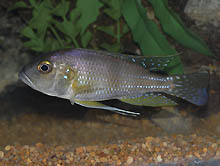
Another recent rarity exported from
Burundi is Limnochromis staneri.
Sporting long ventral fin filaments, this beautiful Limnochromis reportedly grows
larger than other species in the genus.
|
Lake Malawi
General demand for wild-caught Malawi cichlids in the United
States has improved little since my last report. However, sales of
these fishes are, as always, good in Europe and other areas. Small bred
items from various production areas have reasonably good sales.
Hobbyists are looking for the more economical juveniles from the usual
favorite varieties and also the harder to find species, especially
predatory haplochromines.

Collected and shipped rarely from
Tanzania, Aulonocara brevinidus
is generally found over sandy areas. Currently this species is kept and
bred in Europe. Photo by F. Callegari. |

One of the Malawi sand-shifting species
is Taeniolethrinops furcicauda which
is often collected seasonally in the lake. This large fish is a
favorite of Lethrinops fans
and requires large quarters. Photo by F. Callegari. |

Occasionally shipped from Malawi over
the years as Haplochromis Newsi, this fish is actually Otopharnyx selenurus. This
interesting fish is found over sand and is a follower species dependent
on larger sand-shifting cichlid species to feed. Photo by F.
Callegari. |

An unknown species currently bred in
Europe, Lethrinops sp.
‘yellow cap’ is similar to other species found in various places in the
lake. This fish is one of many Lethrinops
that has gained popularity due to coloration and
small adult size. Photo by F. Callegari. |
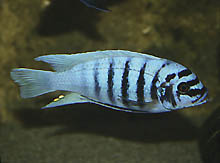
This form of Metriaclima sp. ‘zebra chilumba’
collected from Maison Reef, Malawi, is a jumbo-sized mbuna. Striking
individuals like this make it easy to see why this fish is a popular
item. Photo by F. Callegari. |
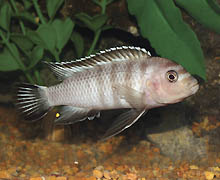
The albino form of Pseudotropheus sp. ‘elongatus
ornatus’ was developed and bred on a fish farm in Florida. This fish is
also known in the US hobby as Likoma Elongatus. It is one of the many
albino Malawi cichlid species developed by breeders. |
Lake Victoria
There is a bit of good news for Victorian cichlid fans in the
USA. Specialty breeders in Europe and elsewhere have several species
not usually commercially bred in America. Some of these infrequent
species were imported recently and distributed to US hobbyists.
Hopefully more of these captive-raised species will arrive again soon.
what's
new: Lake Victoria
|

Originally established from Mwanza,
Tanzanian populations, Yssichromis
piceatus is still maintained in Europe by some dedicated
hobbyists. Good thing too, as the strain has disappeared from US
breeders some time ago! Dominant males of this elongated fish turn
black with red fins. |

Another seldom seen fish from Tanzania
is Lithochromis xanthopteryx
Makombe. Adult males of this fish turn black with orange unpaired fins.
This fish is rarely seen by US hobbyists. |
Neotropics
Increased imports of South American cichlids, and thus
popularity, are due to the increased interest in any and all of the
several dozens of fancy armored L-numbered catfish species. Reports of
successful spawning of different species of these fancy “pleco” catfish
have fueled buying over recent years. They are now popular imports from
Brazil, Columbia, and elsewhere.

This colorful species, Geophagus brokopondo, has been
imported commercially for the first time recently from Surinam. Photo
by O. Lucanus. |
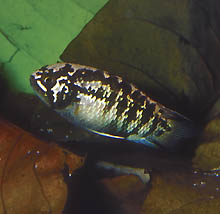
This rare dwarf cichlid, Nannacara adoketa, from the upper
Rio Negro river is exported occasionally from Brazil. Hopefully this
attractive fish will stay in the hobby! Photo by O. Lucanus. |

Apistogramma
sp. “Yawasyacu” from Peru is yet another new species in the A. barlowi group. It will be
some time before we know just how many species of such dwarf
cichlids occur in Peru. Photo by O. Lucanus.
|
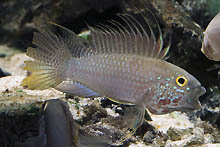
This beautiful new Apistogramma variety is collected
and exported from the border area between Peru and
Brazil. Perhaps this will be a new species to
describe. Photo by O. Lucanus.
|
Select date in side bar to go a What's
New of previous issues
|















